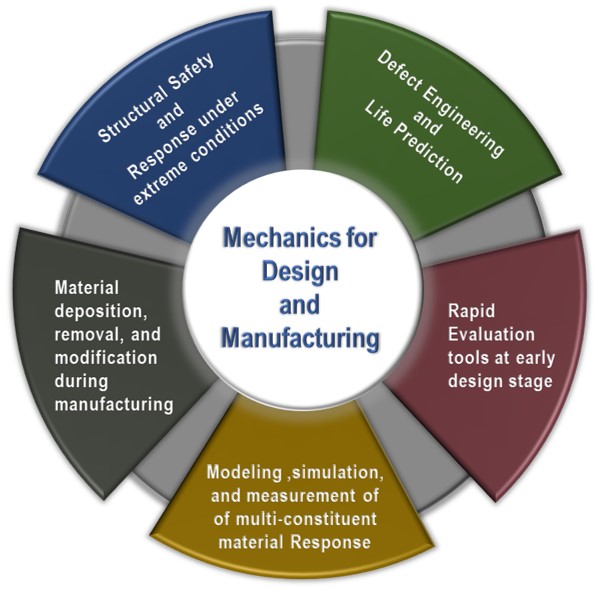
Mission
The Center of Innovation in Mechanics for Design and Manufacturing’s mission is to provide a bridge between the development of new materials and product design, materials processing, durability and life prediction and catastrophe avoidance, particularly in the energy sector.
The center aims to:
- Develop leadership in combining mechanics and data analysis for developing unique knowhow in advanced manufacturing.
- Foster international collaboration to develop the infrastructure (knowhow, tools, training) and advanced technology to design and evaluate custom/high value/small lot components and systems.
- Provide support for industry and address challenges in their transition to advanced manufacturing.
- Provide training and certification in the mechanics-based tools and software that are essential for integrated design and custom manufacturing.
Background
The Center of Innovation in Mechanics for Design and Manufacturing will help to solve several needs.
- Advanced/custom manufacturing needs substantially more mechanics-based simulation and predictive capabilities for successful completion and quality assurance.
- Vertical integration of design, processing and manufacturing using hybrid (additive and subtractive) manufacturing requires new software tools and the knowledge to use them.
- There is an opportunity to reduce lifetime cost of components by using custom manufacturing to repair, replace or re-engineer components on the fly.
- However,
- prediction of durability of critical components delays the adoption of custom manufacturing processes.
- Due to short product life cycles, there is a need to continually redesign components and bring them to market quickly without extensive testing.
- There is a need for a new trained workforce at all levels — from technicians to researchers – who are able to integrate mechanics-based simulations with testing to make rapid evaluations and changes to the manufacturing shop floor itself.
Activities
The proposed activities grouped into technology readiness levels (TRLs), as broadly defined by the U.S. Department of Defense and the European Union, are:
| Technology Readiness Level | Description | Proposed Activity |
|---|---|---|
| TRL 1 | Basic engineering principles development: Scientific research begins to be translated into research and development (R&D) | Research scholar exchange with a focus on research culture |
| TRL 2 | Practical applications being speculated. No validation yet | |
| TRL 3 | Component level proof of concept | Provide access to lab facilities and experimental equipment, develop new instruments and software (open source wherever possible, commercial where needed) |
| TRL 4 | Lab experiments on components | |
| TRL 5 | Integration into a proof of concept system | |
| TRL 6 | Demonstration in real-world environment with ad hoc components | Expert services to industry for troubleshooting |
| TRL 7 | Building of dedicated components and functional prototype | |
| TRL 8 | Technology has been proven to work in its final form and under expected conditions. In nearly all cases, this technology readiness level represents the end of true system development. Examples include developmental test and evaluation of the system in its intended weapon system to determine if it meets design specifications. | |
| TRL 9 | Operational system deployed | Training on use, improvement and repair services (including use of linear and nonlinear finite element analysis and a basic understanding of mechanics) |

